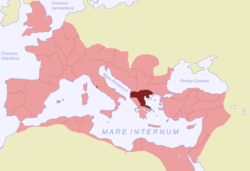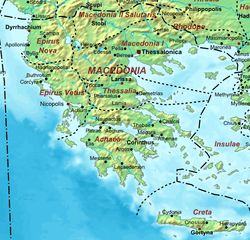Macedonia (Roman province)
| Provincia Macedoniae Επαρχια Μακεδονιας | |||||
| Province of the Roman Empire | |||||
| |||||
 | |||||
| Capital | Thessalonica in Late Antiquity: Thessalonica (Macedonia Prima) and Stobi (Macedonia Salutaris)[1] | ||||
| Historical era | Antiquity | ||||
| • | Established after the Fourth Macedonian War | 146 BC | |||
| • | Balkan interior raided by Slavs | 7th century | |||
| Today part of | | ||||
The Roman province of Macedonia (Latin: Provincia Macedoniae, Greek: Ἐπαρχία Μακεδονίας) was officially established in 146 BC, after the Roman general Quintus Caecilius Metellus defeated Andriscus of Macedon, the last self-styled King of the ancient kingdom of Macedonia in 148 BC, and after the four client republics (the "tetrarchy") established by Rome in the region were dissolved. The province incorporated ancient Macedonia, with the addition of Epirus, Thessaly, and parts of Illyria, Paeonia and Thrace. This created a much larger administrative area, to which the name of 'Macedonia' was still applied. The Dardanians, to the north of the Paeonians, were not included, because they had supported the Romans in their conquest of Macedonia.
Description
Organization
After the reforms of Diocletian in the late 3rd century, Epirus Vetus was split off, and sometime in the 4th century, the province of Macedonia itself was divided into Macedonia Prima in the south and Macedonia Secunda or Salutaris in the north. These provinces were all subordinate to the Diocese of Macedonia, one of three dioceses comprising the praetorian prefecture of Illyricum. When the Prefecture was divided between the Western and Eastern Empires in 379, the Macedonian provinces were included in Eastern Illyricum. With the permanent division of the Empire in 395, Macedonia passed to the East, which would evolve into the Byzantine Empire.
Epirus Vetus

Epirus Vetus ("Old Epirus") was a province in the Roman Empire that corresponded to the region of Epirus. Between 146 BC and 395, it was incorporated into the Roman province of Macedonia. The capital[2] of Epirus vetus was Nicopolis, a city founded by Octavian in memory of his victory over Antony and Cleopatra at Actium.
Epirus Nova
Epirus Nova (New Epirus) or Illyria Graeca[3][4][5] or Illyris proper was a province of the Roman Empire established by Diocletian during his restructuring of provincial boundaries. Until then, the province belonged to the province of Macedonia;[6][7] it later became a theme[8] of the Byzantine Empire. Dyrrachium (or Epidamnus) was established as the capital of Epirus Nova.[9]
The region of Epirus Nova corresponded[10] to a portion of Illyria that was then "partly Hellenic and partly Hellenized".[11] The area was the line of division[12] between the provinces of Illyricum and Macedonia and suffered from terrible earthquakes.
The Ostrogoths, led by Theodoric, were stopped in Epirus Nova by Sabinianus Magnus.[13] They entered in 479 and remained until 482.[14]
Macedonia Prima

Macedonia Prima ("First Macedonia") was a province encompassing most of the kingdom of Macedonia, coinciding with most of the modern Greek region of Macedonia, and had Thessalonica as its capital.
Macedonia Salutaris
Macedonia Salutaris ("Wholesome Macedonia"), also known as Macedonia Secunda ("Second Macedonia") was a province encompassing partially Dardania and the whole of Paeonia, the second being most of the present-day Republic of Macedonia. The town of Stobi located to the junction of the Erigon and Axios rivers, which was the former capital of Paeonia, arose later in the capital city of Macedonia Salutaris.
Economy

The reign of Augustus began a long period of peace, prosperity and wealth for Macedonia, although its importance in the economic standing of the Roman world diminished when compared to its neighbor, Asia Minor.
The economy was greatly stimulated by the construction of the Via Egnatia, the installation of Roman merchants in the cities, and the founding of Roman colonies. The Imperial government brought, along with its roads and administrative system, an economic boom, which benefited both the Roman ruling class and the lower classes. With vast arable and rich pastures, the great ruling families amassed huge fortunes in the society based on slave labor.

The improvement of the living conditions of the productive classes brought about an increase in the number artisans and craftspeople to the region. Stonemasons, miners, blacksmiths, etc. were employed in every kind of commercial activity and craft. Greek people were also widely employed as tutors, educators and doctors throughout the Roman world.
The export economy was based essentially on agriculture and livestock, while iron, copper, and gold along with such products as timber, resin, pitch, hemp, flax and fish were also exported. Another source of wealth was the kingdom's ports, such as Dion, Pella, Thessalonica, Cassandreia.[15]
Episcopal sees
Ancient episcopal sees of the Roman province of Epirus Nova listed in the Annuario Pontificio as titular sees:[16]
- Achrida (O(c)hrid; later also one Latin and three Orthodox Archbishoprics)
- Amantia (Plotscha)
- Apollonia
- Arbanum (near Tiranë)
- Aulona
- Benda (in the region of Bena)
- Chunavia (in the upper Mat valley)
- Croae (Krujë)
- Glavinitza
- Lestrona
- Pulcheriopolis (Berat)
- Scampa (Elbasan)
- Stephaniacum (Stiefan)
- Strumnitza (Strumica)
Ancient episcopal sees of the Roman province of Epirus Vetus listed in the Annuario Pontificio as titular sees:[16]
- Achelous (Angelokastro?)
- Aëtus (Aëtos)
- Bonitza
- Buthrotum
- Dodona
- Euroea in Epiro
- Hadrianopolis in Epiro (Dropull)
- Ioannina
- Leucas
- Nicopolis in Epiro, the Metropolitan Archbishopric
- Onchesmus (Sarandë)
- Phoenice (ruins at Finiki)
- Photice (ruins at Tsiucas)
- Rhoga
Ancient episcopal sees of the Roman province of Macedonia Prima (I) listed in the Annuario Pontificio as titular sees:[16]
- Ardamerium (Ardameri)
- Bargala
- Berrhoea (Veria)
- Campania (Macedonia) (Chalastra)
- Cassandria
- Citrus (Macedonia) (Pydna)
- Dium
- Doberus (Dojran)
- Edessa in Macedonia (Edessa, Greece)
- Heraclea Pelagoniae (Bitola)
- Hierissus (Ierissos)
- Lete (Mygdonia)
- Serbia
- Stobi
- Thessalonica, the Metropolitan Archdiocese
- Zapara
Ancient episcopal sees of the Roman province of Macedonia Secunda (II) listed in the Annuario Pontificio as titular sees:[16]
- Amphipolis
- Christopolis (Kavala)
- Chrysopolis in Macedonia (Orfani)
- Eleutheropolis in Macedonia (Leftero Limani)
- Philippi, the Metropolitan Archbishopric
- Platamon
- Serrae
- Thasos
- Velicia (Drama? Paliokhori?)
Ancient episcopal sees of the Roman province of Thessalia Prima (I) listed in the Annuario Pontificio as titular sees:[16]
Ancient episcopal sees of the Roman province of Thessalia Secunda (II) listed in the Annuario Pontificio as titular sees:[16]
- Marmarizana
- Novae Patrae (Neopatras), the Metropolitan Archbishopric
Notable individuals
Citizens
- Damon of Thessalonica 2nd century BC
Saints and clerics
- Agape, Chionia, and Irene(died 304)
- Agathopous, deacon
- Aristarchus of Thessalonica, 1st century
- Demophilus of Constantinople (died 386), Bishop, born in Thessalonica
- Epaphroditus, first bishop of Philippi
- Gaius, first Bishop of Thessalonica
- Lydia of Thyatira, 1st century
- Matrona of Thessalonica
- Onesimus, first bishop of Beroea
- Saint Demetrius, patron saint of the city of Salonika, martyred in 306
- Theodulus, Lector
Writers
- Craterus of Amphipolis (c. 100-30 BC) Rhapsode winner in Amphiarian games[17]
- Phaedrus of Pieria (c. 15 BC – c. 50 AD), fabulist
- Antipater of Thessalonica (late 1st century BC), epigrammatic poet and governor of the city
- Philippus of Thessalonica (late 1st century AD), epigrammatic poet and compiler of the Greek Anthology
- Archias, epigrammatist
- Antiphanes (late 1st century), epigrammatist
- Parmenio (late 1st century), epigrammatist
- Criton of Pieria, historian
- Polyaenus, (2nd century), military writer
- Stobaeus (5th century), anthologist of Greek authors
- Macedonius of Thessalonica (6th century), epigrammatist of Greek Anthology
Physicians
- Athryilatus of Thasos
- Alexander of Pella
- Damian of Thessalonica
- Anthemius of Edessa
- Paul of Philippi
- Theodorus of Kato Kleines,Florina
- C. Iulius Nicetas of Lyke (Lyki) in Pella
- Aurelius Isidorus of Thessalonica
- Sextus Iulius Chariton of Amphipolis
- Servia of Thessalonica
- Pubicius Lalus and Publicius Hermias of Beroea
- Aelius Nicolaus of Edessa
- Aptus of Dion[18]
See also
References
- ↑ A Companion to Ancient Macedonia, By Joseph Roisman and Ian Worthington, page 549
- ↑ The visible past: Greek and Roman history from archaeology 1960-1990 by Michael Grant, 1990, ISBN 0-684-19124-5, page 98
- ↑ The Loeb Editor's Notes, 28 Nova Epirus or Illyris Graeca
- ↑ A new classical dictionary of Greek and Roman biography, mythology, and geography: partly based upon the Dictionary of Greek and Roman biography and mythology by Sir William Smith,1851,page 392
- ↑ Catholic Encyclopedia - Durazzo
- ↑ Handbook of Ancient Geography and History by Ptz Wilhelm, ISBN 1-113-19974-1, The (734) southern portion, or Illyria Graeca, belonged to the province of Macedonia.
- ↑ Atlas of Classical History by R. Talbert, 1989, page 175: "... divided the diocese of Moesia into two, styled Thracia and Macedonia, the latter consisting of the provinces from Epirus Nova and Macedonia southward. But there is evidence that Constantine considered ..."
- ↑ Encyclopedia of ancient Greece by Nigel Guy Wilson, 2006, ISBN 0-415-97334-1, page 246
- ↑ Hendry, p. 299. The geography is entirely correct for Servius' time, since Diocletian's rearrangement of provincial boundaries included the creation of the province of Epirus Nova out of southern Illyricum with Dyrrachium (=Epidamnus) as its capital.
- ↑ Wilkes, J. J. The Illyrians, 1992,ISBN 0-631-19807-5,Page 210
- ↑ Athanassakis, A.N. (1977), "N.G.L. Hammond, Migrations and Invasions in Greece and Adjacent Areas (review)", American Journal of Philology 99: 263–6, JSTOR 293653
- ↑ Migrations and invasions in Greece and adjacent areas by Nicholas Geoffrey Lemprière Hammond, 1976, ISBN 0-8155-5047-2, page 54: The line of division between Illyricum and the Greek area Epirus nova
- ↑ A history of the Ostrogoths by Thomas S. Burns,1991,ISBN 0-253-20600-6,page 63
- ↑ Epirus Vetus: The Archaeology of a Late Antique Province (Duckworth Archaeology) by William Bowden, 2003, ISBN 0-7156-3116-0, 2003, page 196
- ↑ Macedonia - Province of the Roman Empire
- 1 2 3 4 5 6 Annuario Pontificio 2013 (Libreria Editrice Vaticana 2013 ISBN 978-88-209-9070-1), "Sedi titolari", pp. 819-1013
- ↑ Amphiareion — c. 80-50 BC Epigraphical Database
- ↑ www.phl.uoc.gr/eulimene/eulimene03.pdf
| ||||||||
| ||||||||||||||||||||||||||||||||||||||||||||||||||||||||||||||||||||||||||
